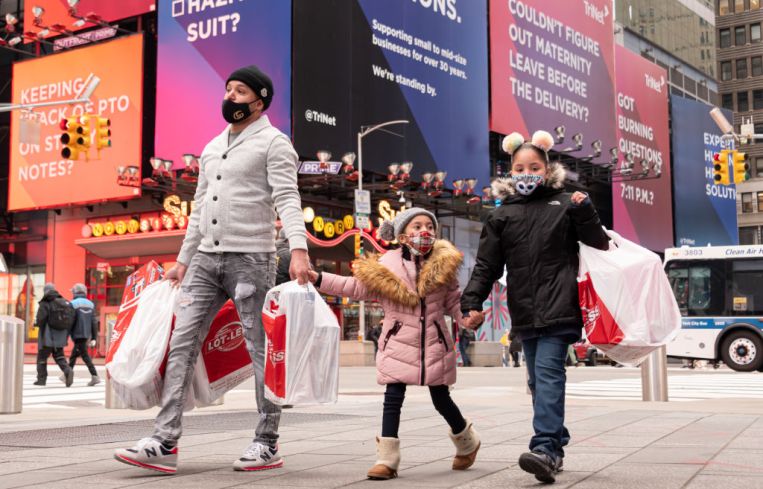Foot Traffic in NYC Shopping Corridors Picking Up, but Omicron Variant Not Helping
By Celia Young December 14, 2021 6:28 pm
reprints
Manhattan and Brooklyn’s shopping areas are seeing a slight resurgence in visitors with more expected over the Christmas season, even as the coronavirus and its more-contagious omicron variant continue to depress pedestrian traffic below pre-pandemic levels, according to data from analytics firm Springboard.
Visits to popular shopping areas within the two boroughs — from Dumbo, Brooklyn to Times Square — strengthened in November to just under 31 percent below November 2019 levels, and 41 percent below October 2019 figures, according to Springboard, which uses electronic counting devices to track foot traffic in key spots in Manhattan and Brooklyn.
“We do expect an increase [in foot traffic] towards Christmas,” Diane Wehrle, marketing and insights director at Springboard, told Commercial Observer. “Despite the omicron variant, people will go out to buy gifts and presents. We are expecting an increase but that increase isn’t as big as we might have had without omicron. So it’s peculiar, the [recent] uplift.”
Nationally, this November pedestrian traffic to downtown areas across the United States was 30 percent below 2019 levels in November compared to 38 percent below in October, according to Springboard. November saw the greatest monthly improvement in downtown visits in 2021 — a good sign for retail and restaurants in sections often populated by office workers.
Visits to the key shopping areas in New York City and the United States as a whole have ticked up far above levels seen last year — when government restrictions kept many who could afford to stay home or out of the office away from shopping and business centers. But traffic hasn’t improved as much as expected, and these spots could be looking at permanently losing business to online shopping, Wehrle said.
“We seem to keep getting new variants and we’re expecting that to continue so … we’re expecting to stay below 2019 levels for quite a while, partly because some of the downtown traffic has been transferred online,” Wehrle said.
The omicron variant — which has caused at least 20 confirmed cases of the coronavirus in New York state — has hampered downtown recoveries as well. A full-scale return-to-office is seeming increasingly unlikely, with massive employer Google already further delaying its homecoming due to the new variant. Gov. Kathy Hochul also required businesses that don’t have a vaccine mandate for patrons to instruct customers to wear masks while indoors starting Monday.
Without an end to the pandemic — and its ensuing change in remote working habits — in sight, New York City’s shopping corridors are not out of the woods yet. Supply chain issues are another factor Wehrle is keeping an eye on that could negatively impact the amount of people visiting
“[If you] go into a store [and] you can’t find what you want, that’s gonna put you off in terms of shopping,” Wehrle said. “For some people their first stop is online because they’ve got a greater guarantee of getting the goods they want to buy.”
Still, brick-and-mortar retailers are more resilient than often given credit for, seeing a more stable stream of traffic in downtowns across the U.S., said Wehrle. Black Friday was a particularly optimistic sign for in-person shopping, as downtowns across the U.S. saw increased pedestrian traffic compared to the week prior.
“Everyone talks about the death of the physical stores … [and] that is certainly not the case,” Wehrle said. “Shoppers want to go to brick-and-mortar stores, they love the atmosphere … The tradition of post-Thanksgiving, when everyone’s been eating and drinking a lot and they want to go out the day after, that seems to be holding.”
Visits to indoor U.S. malls on Black Friday surpassed numbers from last year by about 83.5 percent, according to data from analytics firm Placer.ai. And the commercial brokerage firm CBRE is predicting an 8.4 percent rise in holiday retail sales this year, though it remains to be seen how much of that shopping will be done in-person or online.
Celia Young can be reached at cyoung@commercialobserver.com.



